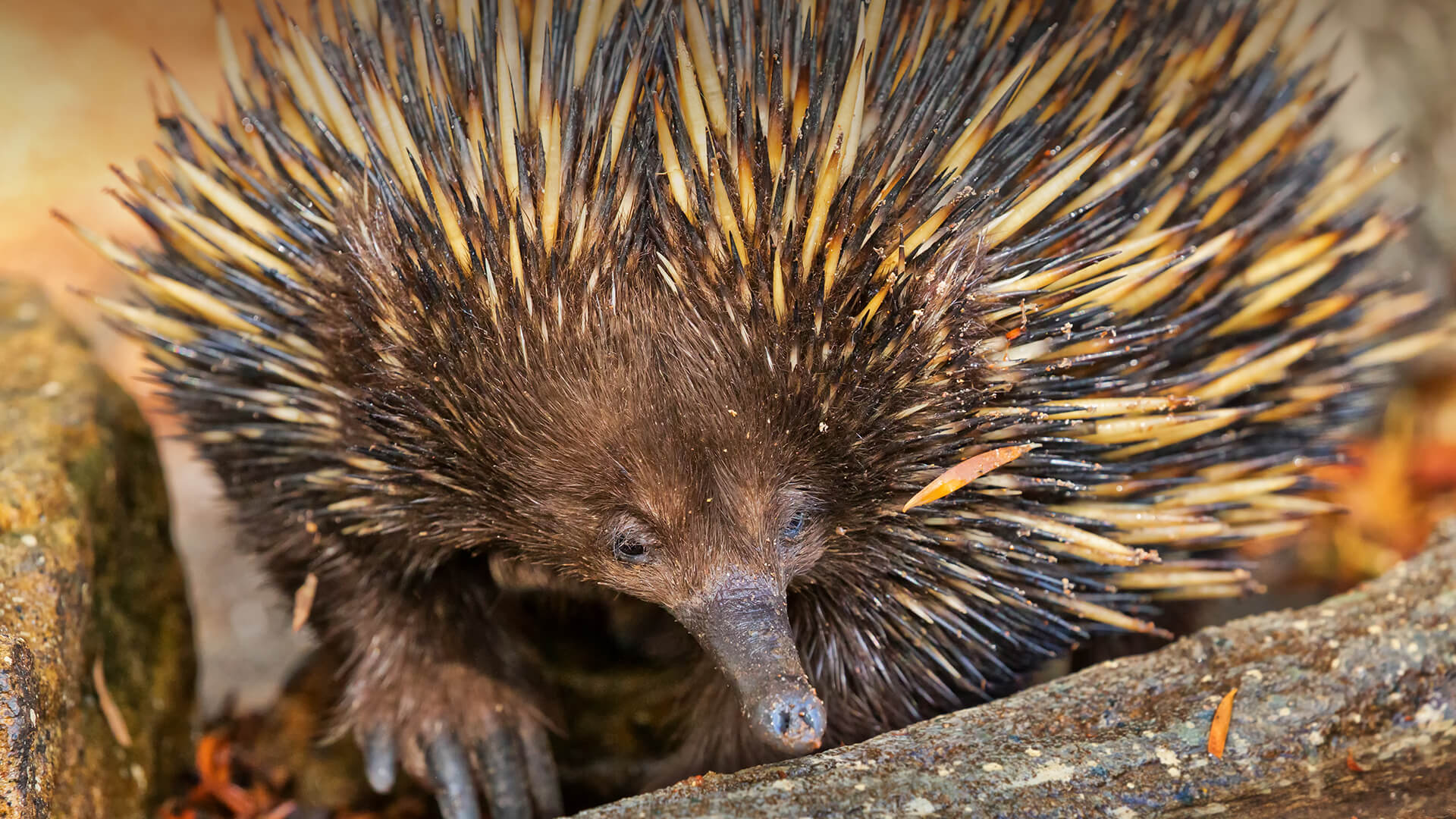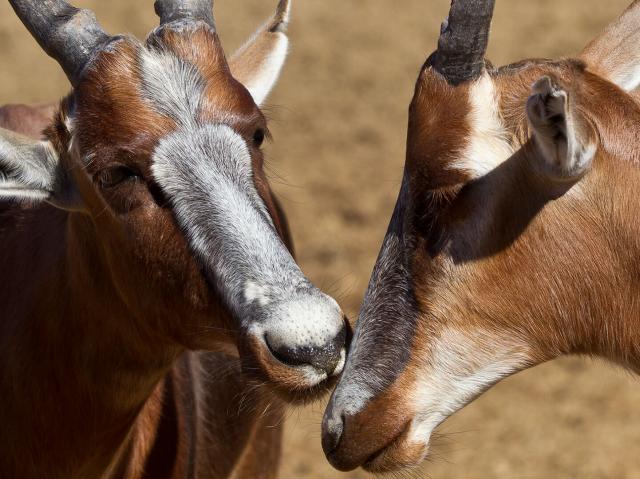
Echidna

- Class: Mammalia (Mammals)
- Order: Monotremata (Monotreme)
- Family: Tachyglossidae
- Genus: Tachyglossus and Zaglossus
- Species: T. aculeatus, Z. bruijnii, Z. attenboroughi, Z. bartoni

ABOUT
The echidna (ih-KID-na), sometimes called a "spiny anteater," is an unusual mammal. It is so different from any other that it still puzzles researchers and scientists. The echidna has remained unchanged since prehistoric times, finding ways to survive while other species became extinct. But what really sets echidnas apart from other mammals? Female echidnas lay eggs! Egg-laying mammals are called monotremes. There are only five monotremes in the world: four echidna species, and one platypus species.
Echidnas are found from the highlands to the deserts and forests throughout Australia, including Tasmania, as well as Indonesia and Papua New Guinea on the island of New Guinea. They're solitary and tend to be active during the day, evening, or both, depending on the season and available food sources.
An echidna has a tiny face with small eyes and a long nose, sometimes called a beak. The eyes don’t help the echidna see well, but its acute sense of hearing and smell give this unusual mammal the information it needs to know to survive.
The short-beaked echidna has dark fur almost completely hidden by a covering of hollow, barbless quills, called spines, on its back and sides. Long-beaked echidnas have less fur and more visible spines. The beige-and-black spines on all four species, which are about 2 inches (5 centimeters) long, help camouflage the echidna in the brush.
The echidna’s short legs are ideal for digging. The hind legs point backward, with an extra-long claw on the second toe that can be used to “comb” or scratch out dirt and bugs that get wedged between the echidna’s spines. Its powerful front feet can dig straight down into the earth. The claws on its front legs are also useful for tearing open termite mounds.
Digging in for protection. Other than fires and drought, the main threats to the slow-moving echidna are feral dogs and cats as well as dingoes and foxes. Cars also kill hundreds of these animals each year on the roadways of Australia. The echidna has three options when faced with danger: run away on its short, stubby legs, dig, or curl up.
The echidna’s digging ability is usually its best bet. Some say it can dig a hole just as fast as a human using a shovel can! The echidna digs straight into the dirt until only a spiny rear end can be seen, making it almost impossible for a predator to grab and pull it out. It can also protect itself by curling up into a tight, spiky ball, hiding its face and feet. Surprisingly, the echidna is an excellent swimmer and tree climber, too!
HABITAT AND DIET
Echidnas inhabit scrubland, desert, and montane forest throughout Australia including Tasmania, in addition to Indonesia and Papua New Guinea on the island of New Guinea. Digging for food and shelter is key, so areas with loose topsoil work well, though these animals can plow through hard-packed dirt as well.
The nostrils at the tip of the beak help the echidna sniff out its next meal. The rubbery snout is also sensitive to electrical signals from an insect’s body. It is strong enough to break open hollow logs and plow up the forest floor in search of insects.
An echidna’s typical day begins by finding something to eat. Like anteaters, the echidna has no teeth. So how does it eat? The echidna has a long, sticky tongue to catch and chew its food: ants, termites, or earthworms. Once food is located, the echidna tears into the mound or nest with its large, sharp claws and then uses the 6-inch (15-centimeter) tongue to lap up the bugs or worms. Hard pads at the base of the tongue and on the roof of the mouth grind the food into a paste for swallowing.
Echidnas at zoos are fed a “milkshake” made of ground-up leaf eater biscuits and dog kibble, with water added to form a thick paste to lick up.
FAMILY LIFE
Echidna breeding season is during July and August. An adult female echidna usually lays a single, leathery egg once a year. She rolls the newly laid egg, about the size of a grape, into a deep pocket, or pouch, on her belly to keep it safe. Ten days later, the baby echidna, called a puggle, hatches. It is smaller than a jelly bean! The puggle uses its tiny, see-through claws to grip the special hairs within the mother’s pouch. The mother does not have nipples the way other mammals do. Instead, the little puggle laps up milk that the mother’s body secretes from special glands in her pouch.
Fortunately for the mother, the puggle does not yet have spines sticking out! It remains in the pouch until its spines begin to break through its skin, at about 53 days. Then the mother puts the puggle into a burrow, where she returns to feed it every 5 to 10 days until it is big enough to go out on its own, at about 7 months old.
The echidna is one of the Earth’s oldest surviving species. Yet there are many questions scientists still have about this elusive animal. What is its life span in the wilderness? When is an echidna old enough to start a family? What is the mother/puggle relationship like? What are its daily habits? It’s fun to realize that there is still so much to learn about animals. The echidna has many surprises yet to reveal!
CONSERVATION
We're working to create a brighter future for echidnas and the dynamic landscapes they rely on through our Australian Forest Conservation Hub.
The International Union for Conservation of Nature (IUCN) evaluates the conservation status of plant and animal species, with the particular goal of identifying species at risk of extinction. The results are published in the IUCN Red List of Threatened Species.
The IUCN categorizes the short-beaked echidna Tachyglossus aculeatus as a species of Least Concern.
On the island of New Guinea, various species of long-beaked echidnas are primarily threated by habitat loss and fragmentation in addition to challenges related to human-wildlife coexistence.
Sir David’s long-beaked echidna Zaglossus attenboroughi is Critically Endangered. The extent of its occurrence is less than 8 square miles (20 square kilometers), and the population is likely decreasing. In fact, this species may already be extinct.
The western long-beaked echidna Z. bruijnii is Critically Endangered, and the population is decreasing.
The eastern long-beaked echidna Z. bartoni is recognized as Vulnerable. Although there are estimated to be as many as 10,000 mature individuals, the population is decreasing, and this species is extinct in some parts of its former range.
LIFE SPAN
Up to 58 years in zoos; unknown in the wild
YOUNG
Gestation: 3 to 4 weeks
Number of young: Usually 1
Size at hatch: 0.47 inches (12 millimeters), 0.02 ounces (0.56 grams)
Maturity: Unknown
SIZE
Length: 14 to 30 inches
Weight: 5.5 to 22 pounds (2.5 to 10 kilograms)
FUN FACTS
Egg-laying mammals are called monotremes. There are only five monotremes in the world: four species of echidnas plus the platypus.
The taxonomic family name for echidnas, Tachyglossidae, means “fast tongue.”
Both male and female echidnas have a pouch on the belly, making it difficult to tell one from the other.
The echidna’s snout is very sensitive to touch and can feel vibrations.
What? An echidna does not have ear flaps like we do. Its ears are large, vertical slits just behind its eyes. It has an amazing sense of hearing.
Its body temperature is lower than that of most other mammals and is not controlled in the same way.
The Sir David's long-beaked echidna is named for Sir David Attenborough, a British naturalist famous for his nature films.










